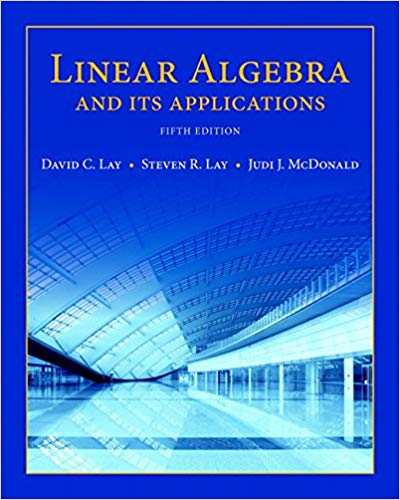
Linear Algebra and Its Applications, 5th Edition
Authors: David C. Lay, Steven R. Lay, Judi J. McDonald
ISBN-13: 978-0321982384
We have solutions for your book!
See our solution for Question 14E from Chapter 1.3 from Lay's Linear Algebra and Its Applications, 5th Edition.
Problem 14E
Chapter:
Problem:
Determine if b is a linear combination of the vectors formed from the columns of the matrix A...
Step-by-Step Solution
Step 1: Given information
Given Matrix, A and vector, $\bf{b}$:
\[\begin{array}{l}A = \left[ {\begin{array}{*{20}{c}}1&{ - 2}&{ - 6}\\0&3&7\\1&{ - 2}&5\end{array}} \right]\\{\bf{b}} = \left[ {\begin{array}{*{20}{c}}{11}\\{ - 5}\\9\end{array}} \right]\end{array}\]We have to determine, whether the vector $\bf{b}$ is a linear combination of vectors formed from the columns of the matrix A.
Step 2: Form the vectors from the columns of matrix A
\[{{\bf{a}}_1} = \left[ {\begin{array}{*{20}{l}}1\\0\\1\end{array}} \right],{{\bf{a}}_2} = \left[ {\begin{array}{*{20}{c}}{ - 2}\\3\\{ - 2}\end{array}} \right],{{\bf{a}}_3} = \left[ {\begin{array}{*{20}{c}}{ - 6}\\7\\5\end{array}} \right]\]
Step 3: Augmented Form
Convert the vectors ($\bf{a_1, a_2, a_3}$ and $\bf{b}$) into augmented form.\[\begin{array}{l}\left[ {\begin{array}{*{20}{c}}{{{\bf{a}}_{\bf{1}}}}&{{{\bf{a}}_{\bf{2}}}}&{{{\bf{a}}_{\bf{3}}}}&{\bf{b}}\end{array}} \right]\\A = \left[ {\begin{array}{*{20}{c}}1&{ - 2}&{ - 6}&{11}\\0&3&7&{ - 5}\\1&{ - 2}&5&9\end{array}} \right]\end{array}\]
Step 4: Convert to echelon form
\[\begin{array}{l}A = \left[ {\begin{array}{*{20}{c}}1&{ - 2}&{ - 6}&{11}\\0&3&7&{ - 5}\\1&{ - 2}&5&9\end{array}} \right]\\ = \left[ {\begin{array}{*{20}{c}}1&{ - 2}&{ - 6}&{11}\\0&3&7&{ - 5}\\0&0&{11}&{ - 2}\end{array}} \right]\,\,\,::\,\,\left\{ {{R_3} = {R_3} - {R_1}} \right\}\\ = \left[ {\begin{array}{*{20}{c}}1&{ - 2}&{ - 6}&{11}\\0&1&{\dfrac{7}{3}}&{\dfrac{{ - 5}}{3}}\\0&0&{11}&{ - 2}\end{array}} \right]\,\,::\,\,\left\{ {{R_2} = \dfrac{{{R_2}}}{3}} \right\}\\ = \left[ {\begin{array}{*{20}{c}}1&0&{ - \dfrac{4}{3}}&{\dfrac{{23}}{3}}\\0&1&{\dfrac{7}{3}}&{\dfrac{{ - 5}}{3}}\\0&0&{11}&{ - 2}\end{array}} \right]\,\,::\,\,\left\{ {{R_1} = {R_1} + 2{R_2}} \right\}\\ = \left[ {\begin{array}{*{20}{c}}1&0&{ - \dfrac{4}{3}}&{\dfrac{{23}}{3}}\\0&1&{\dfrac{7}{3}}&{\dfrac{{ - 5}}{3}}\\0&0&1&{\dfrac{{ - 2}}{{11}}}\end{array}} \right]\,\,::\,\,\left\{ {{R_3} = \dfrac{{{R_3}}}{{11}}} \right\}\\ = \left[ {\begin{array}{*{20}{c}}1&0&0&{\dfrac{{245}}{{33}}}\\0&1&0&{\dfrac{{ - 41}}{{33}}}\\0&0&1&{\dfrac{{ - 2}}{{11}}}\end{array}} \right]\,\,::\,\,\left\{ \begin{array}{l}{R_1} = {R_1} + \dfrac{4}{3}{R_3}\\{R_2} = {R_2} - \dfrac{7}{3}{R_3}\end{array} \right\}\end{array}\]
Step 5: The solution set
\[{x_1} = \dfrac{{245}}{{33}},{x_2} = \dfrac{{ - 41}}{{33}},{x_3} = \dfrac{{ - 2}}{{11}}\]
ANSWER
As we are able to find a unique solution, the vector $b$ is a linear combination of column of matrix $A$. ,
\[\dfrac{{245}}{{33}}{{\bf{a}}_1} - \dfrac{{41}}{{33}}{{\bf{a}}_2} - \dfrac{2}{{11}}{{\bf{a}}_3} = {\bf{b}}\]
Given Matrix, A and vector, $\bf{b}$:
\[\begin{array}{l}A = \left[ {\begin{array}{*{20}{c}}1&{ - 2}&{ - 6}\\0&3&7\\1&{ - 2}&5\end{array}} \right]\\{\bf{b}} = \left[ {\begin{array}{*{20}{c}}{11}\\{ - 5}\\9\end{array}} \right]\end{array}\]We have to determine, whether the vector $\bf{b}$ is a linear combination of vectors formed from the columns of the matrix A.
Step 2: Form the vectors from the columns of matrix A
\[{{\bf{a}}_1} = \left[ {\begin{array}{*{20}{l}}1\\0\\1\end{array}} \right],{{\bf{a}}_2} = \left[ {\begin{array}{*{20}{c}}{ - 2}\\3\\{ - 2}\end{array}} \right],{{\bf{a}}_3} = \left[ {\begin{array}{*{20}{c}}{ - 6}\\7\\5\end{array}} \right]\]
Step 3: Augmented Form
Convert the vectors ($\bf{a_1, a_2, a_3}$ and $\bf{b}$) into augmented form.\[\begin{array}{l}\left[ {\begin{array}{*{20}{c}}{{{\bf{a}}_{\bf{1}}}}&{{{\bf{a}}_{\bf{2}}}}&{{{\bf{a}}_{\bf{3}}}}&{\bf{b}}\end{array}} \right]\\A = \left[ {\begin{array}{*{20}{c}}1&{ - 2}&{ - 6}&{11}\\0&3&7&{ - 5}\\1&{ - 2}&5&9\end{array}} \right]\end{array}\]
Step 4: Convert to echelon form
\[\begin{array}{l}A = \left[ {\begin{array}{*{20}{c}}1&{ - 2}&{ - 6}&{11}\\0&3&7&{ - 5}\\1&{ - 2}&5&9\end{array}} \right]\\ = \left[ {\begin{array}{*{20}{c}}1&{ - 2}&{ - 6}&{11}\\0&3&7&{ - 5}\\0&0&{11}&{ - 2}\end{array}} \right]\,\,\,::\,\,\left\{ {{R_3} = {R_3} - {R_1}} \right\}\\ = \left[ {\begin{array}{*{20}{c}}1&{ - 2}&{ - 6}&{11}\\0&1&{\dfrac{7}{3}}&{\dfrac{{ - 5}}{3}}\\0&0&{11}&{ - 2}\end{array}} \right]\,\,::\,\,\left\{ {{R_2} = \dfrac{{{R_2}}}{3}} \right\}\\ = \left[ {\begin{array}{*{20}{c}}1&0&{ - \dfrac{4}{3}}&{\dfrac{{23}}{3}}\\0&1&{\dfrac{7}{3}}&{\dfrac{{ - 5}}{3}}\\0&0&{11}&{ - 2}\end{array}} \right]\,\,::\,\,\left\{ {{R_1} = {R_1} + 2{R_2}} \right\}\\ = \left[ {\begin{array}{*{20}{c}}1&0&{ - \dfrac{4}{3}}&{\dfrac{{23}}{3}}\\0&1&{\dfrac{7}{3}}&{\dfrac{{ - 5}}{3}}\\0&0&1&{\dfrac{{ - 2}}{{11}}}\end{array}} \right]\,\,::\,\,\left\{ {{R_3} = \dfrac{{{R_3}}}{{11}}} \right\}\\ = \left[ {\begin{array}{*{20}{c}}1&0&0&{\dfrac{{245}}{{33}}}\\0&1&0&{\dfrac{{ - 41}}{{33}}}\\0&0&1&{\dfrac{{ - 2}}{{11}}}\end{array}} \right]\,\,::\,\,\left\{ \begin{array}{l}{R_1} = {R_1} + \dfrac{4}{3}{R_3}\\{R_2} = {R_2} - \dfrac{7}{3}{R_3}\end{array} \right\}\end{array}\]
Step 5: The solution set
\[{x_1} = \dfrac{{245}}{{33}},{x_2} = \dfrac{{ - 41}}{{33}},{x_3} = \dfrac{{ - 2}}{{11}}\]
ANSWER
As we are able to find a unique solution, the vector $b$ is a linear combination of column of matrix $A$. ,
\[\dfrac{{245}}{{33}}{{\bf{a}}_1} - \dfrac{{41}}{{33}}{{\bf{a}}_2} - \dfrac{2}{{11}}{{\bf{a}}_3} = {\bf{b}}\]